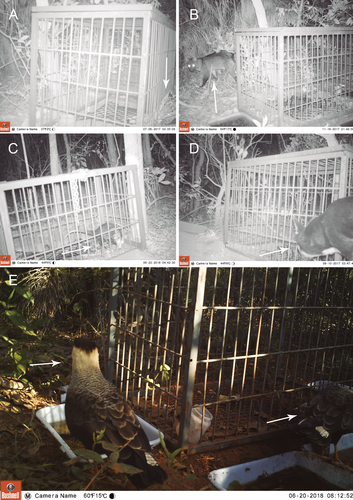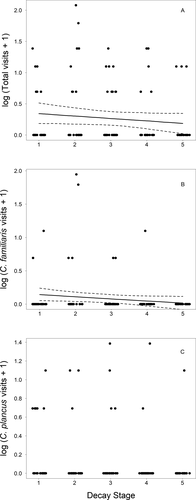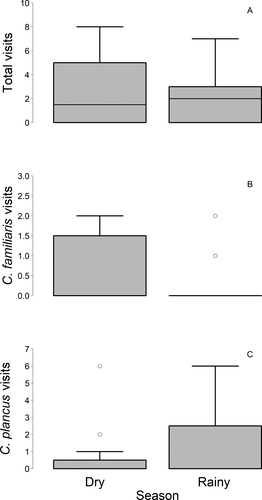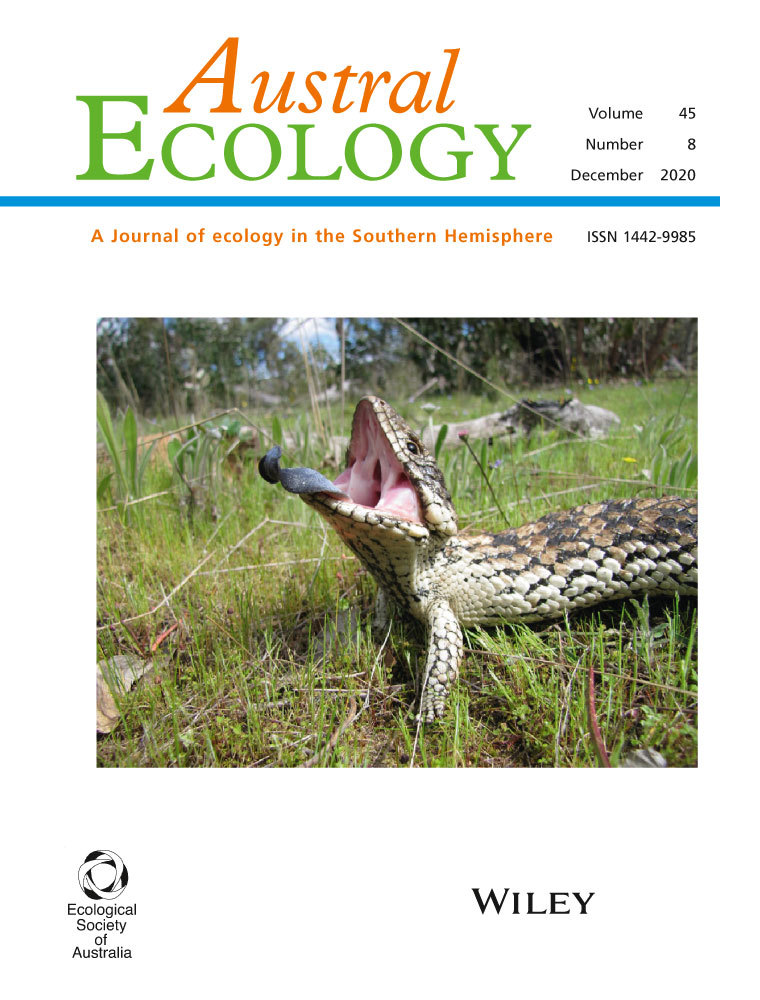Vertebrate scavengers alter the chronology of carcass decay
Abstract
When feeding on exposed corpses, vertebrate scavengers can alter the chronology of decay and interfere with post-mortem interval estimation. However, information on vertebrate scavengers’ actions in areas of the Brazilian Cerrado is scarce, which may constrain future criminal investigations. Thus, we aimed to identify the vertebrate species that visit carcasses, determine whether the number of visits between seasons and among phytophysiognomies varies and examine whether decay stage influences attractiveness to vertebrate scavengers. We obtained data using camera traps installed in two protected areas with three Cerrado phytophysiognomies. The 2032 photographs and 109 videos obtained showed that eight mammal and one bird species interacted with the carcasses. Canis familiaris and Caracara plancus had the highest numbers of carcass visits and feeding events. Stage of decay negatively influenced the number of mammal visits to the carcasses, but bird visits were not affected. Seasons did not affect visit number, and most visits occurred in the cerrado sensu stricto. Because they interfere with the decay process, possibly compromising evidence interpretation, scavengers should be considered in forensic analyses.
Introduction
A corpse or carcass is an ephemeral, high-quality resource that releases a restricted agglomeration of nutrients into the soil during decomposition (Carter et al. 2007). Scavenging is the habit of a species of feeding on decaying animal tissue or consuming corpses (Nourteva 1977). The decay of a corpse begins with chemical decomposition through the action of microorganisms, followed by physical decomposition by the action of animals, mainly insect scavengers (Nourteva 1977; Smith 1986).
Several authors have described the phases of the decay process (Bornemissza 1957; Payne 1965). Payne (1965) defined five stages, beginning at the moment of death. First, there is a fresh body phase, which ends with swelling of the corpse and is followed by strong odours and loss of biomass caused by tissue disruption. Then, most soft tissues degrade and the door phase ends. In the end, only dry skin, cartilage and bones remain, and the carcass is skeletonised. These stages of decomposition vary over time and space. They may be influenced by bacteria and animals – mainly insects – (biotic factors), and by temperature, humidity and precipitation (abiotic factors). These factors must be taken into account in the post-mortem interval (PMI) estimation process (Nourteva 1977; Smith 1986).
Flies and beetles are the most commonly studied taxa in forensic entomology (Smith 1986). These animals can use carcasses as shelter or breeding ground. Necrophagous animals may also use decaying carcasses as a source of protein for themselves or their young. Vertebrates use carrion resources more extensively, and intense competition can occur between scavengers and vertebrate decomposers, especially in hot climates (DeVault et al. 2003), as in the Cerrado. Wilson and Wolkovich (2011) inferred that the underestimation of the habit of eating carrion is 16-fold in researches on food chains; this results in inflated rates of predation and underestimated indirect effects, when the process of eating carrion actually transfers more energy to the food chain than the process of predation. The literature describes the behaviour of scavengers of different vertebrate species with emphasis on large and medium-sized mammals, such as coyotes (Canis latrans), wolves (Canis lupus) and mountain lions (Puma concolor). Scavenger birds play a vital role in our ecosystems, cleaning carcasses before they rot. Without these birds, decaying carcasses would become the focus of harmful pathogens. Vultures are the most specialised birds for eating carrion, being highly efficient in cleaning a carcass. However, other birds, such as eagles, also take advantage of carrion when they have the opportunity.
The behaviours of these various taxa impact carcasses in different ways. The impacts of mammals are better known than those of birds (Petersen 2013). Vertebrates can be associated with death scenes, accelerating the decomposition process through their eating activities or altering crime scenes by moving or changing the corpse deposition site (Blanc-Celino et al. 2013). Moreover, vertebrate scavenging can produce false traces that are not related to a crime, potentially compromising the evidence interpretation and generating confusion in the expert’s report (Byard et al. 2002). Attention has to be given particularly to scavenging by non-terrestrial carnivores (e.g. vultures), which can alter the predictability of patterns of dispersion of remains at the crime scene (Reeves 2009; Spradley et al. 2012). Vertebrate activity can also modify the chronology of the decay process, interfering with the estimation of the PMI. Vertebrate interference can significantly reduce accuracy of the PMI analysis (Steadman et al. 2018) as they can destroy the soft parts of the corpse, spread and bury bones and severely alter the crime scene (Demo et al. 2013).
Because of these confusing actions of vertebrates on carcasses, we used iron cages to prevent vertebrates from manipulating forensic entomology experiments with pig carcasses in the Cerrado biome (Faria et al. 2018; Lira et al. 2019). However, some unanswered questions remain as follows: (i) Which vertebrate species visit and possibly remove or consume carcasses in the Cerrado? (ii) Does the frequency of vertebrate visits vary between seasons and among different phytophysiognomies in the biome? (iii) Do vertebrate scavengers change the chronology of carcass decomposition in Cerrado environments? Therefore, we aimed to answer these questions by identifying the vertebrate species that visit the carcasses, verifying whether the number of visits between seasons and among phytophysiognomies varies, and examining whether the decay stage influences the attractiveness of vertebrate scavengers.
Methods
Cerrado is a biome that covers 20% of the Brazilian territory, and it has several phytophysiognomies that vary in the extent of tree coverage. The Cerrado sensu stricto (s.s.) phytophysiognomy is composed of a continuous ground layer dominated by grasses, and a woody layer of trees and shrubs covering 10–60% of the ground. In contrast, Campo Sujo comprises grassland savanna with a few scattered shrubs and small trees, whereas Gallery Forest has a forest-type vegetation growing along watercourses (Eiten 1978). Cerrado has a well-defined dry season from April to September and a rainy season from October to March (Eiten 1972). We established fixed sampling sites in Cerrado s.s., Gallery Forest and Campo Sujo areas in the Água Limpa Farm (FAL) and National Park of Brasília (PNB) study areas. FAL has a total area of 4390 ha and elevation of 1066 m. PNB has 42 389 ha and is under 1200 m in elevation. These areas are 30 km apart from each other, and all fixed sampling points were separated by a minimum of 3 km.
We sampled the two areas in June, July, August, October, November and December of 2017 and 2018. For the experiment, we used 72 small pig (Sus scrofa) carcasses weighing 2.0–2.5 kg. Each carcass was placed inside an iron cage measuring 1 m × 1 m × 80 cm with a 2.5-cm mesh. Each carcass and its respective cage were identified with the same number. We placed each numbered cage in one area/phytophysiognomy/month of observation. We placed all 72 pig carcasses inside cages, and these cages were distributed in each phytophysiognomy (Cerrado s.s., Gallery Forest and Campo Sujo; 24 cages per phytophysiognomy) and area (FAL and PNB; 36 per area). The main objective of using iron cages was to allow the entry of insects and to minimise vertebrate interference with the carcasses.
The carcasses were kept inside the cages from the fresh stage, through the bloated stage, active decomposition, advanced decomposition, until skeletonisation (see Payne 1965). We registered these decomposition stages by taking daily photographs throughout the experiment, and based on an experienced observer’s analysis. Vertebrate visits were considered when a vertebrate approach included sniffing, licking, biting, pecking or feeding on the carcass. Camera traps (Bushnell HD 2010 model 119676 with resolution 8 Mpx) were installed at each of the sampling points to photograph and film the vertebrates’ actions on the carcass or the entry of small vertebrates into the cage. We checked the camera traps daily to ensure their correct functioning during the experiment.
To test the effects of season and decay stage on the number of vertebrate visits to carcasses, we used generalised mixed models (GLMM) with a Poisson distribution. To control the effect of an individual carcass on the temporal variation of the scavenger visits, we considered carcass identity (carcass number) as a random effect in a repeated measure design (Zuur et al. 2009). Season and decay stage were considered as fixed effects in the independent models. We used a maximum likelihood test to compare the parameters estimated by the models with a null model, in which the response variable (number of visits) varied only according to the random effect (carcass number or identity), to test the significance of the models. We performed the analyses using the ‘lme4’ package (Bates et al. 2015) in the R 3.6.1 program (R Core Team 2019) following the protocols proposed by Zuur et al. (2009).
Results
Camera traps yielded 2032 photographs and 109 videos, revealing eight species of mammals and one bird visiting the decaying carcasses (Table 1; Fig. 1). Canis familiaris (domestic dog; Fig. 1d) and Caracara plancus (caracara; Fig. 1e) were the species with the highest numbers of carcass visits. The number of visits was negatively influenced by the decay stage when considering all vertebrates (Fig. 2a) and dogs only (Fig. 2b); however, there was no difference among the decay phases for the caracara (Fig. 2c), which visited the carcasses consistently throughout the decay process (Table 2). The mean number of total visits of C. familiaris and C. plancus to the pig carcasses during the dry and rainy seasons in Cerrado habitats showed no significant difference (Fig. 3).
| Species | Common name | Fed on carcass? | Area |
|---|---|---|---|
| Canis familiaris | Feral/domestic dog | Yes | FAL |
| Leopardus pardalis | Ocelot | Yes | FAL |
| Cerdocyon thous | Bush dog | Yes | FAL and PNB |
| Myrmecophaga tridactyla | Giant anteater | No | PNB |
| Chrysocyon brachyurus | Maned wolf | No | FAL and PNB |
| Tapirus terrestris | Tapir | No | PNB |
| Didelphis albiventris | White-eared opossum | Yes | FAL |
| Rodentia sp. | Rat | No | FAL and PNB |
| Caracara plancus | Caracara | Yes | FAL and PNB |


| (a) Total visits | |||||
| Random effects | Std. dev. | ||||
| Carcass identity | 0.207 | ||||
| Residuals | 0.446 | ||||
| Fixed effects | Estimate | Std. error | Chisq | Chi d.f. | P-value |
| Intercept | 0.384 | 0.104 | |||
| Decay stage | −0.039 | 0.029 | 3.521 | 1 | 0.061 |
| (b) C. familiaris visits | |||||
| Random effects | Std. dev. | ||||
| Carcass identity | 0.073 | ||||
| Residuals | 0.294 | ||||
| Fixed effects | Estimate | Std. error | Chisq | Chi d.f. | P-value |
| Intercept | 0.173 | 0.065 | |||
| Decay stage | −0.032 | 0.019 | 7.535 | 1 | 0.006 |
| (c) C. plancus visits | |||||
| Random effects | Std. dev. | ||||
| Carcass identity | 0.158 | ||||
| Residuals | 0.281 | ||||
| Fixed effects | Estimate | Std. error | Chisq | Chi d.f. | P-value |
| Intercept | 0.218 | 0.068 | |||
| Decay stage | −0.032 | 0.018 | 2.446 | 1 | 0.118 |
- The chi-square values and P-values are associated with a maximum likelihood test.

Although Leopardus pardalis (ocelot; Fig. 1a) had few interactions with the carcasses, the filming of a female with her kitten indicated eating behaviour in the early morning hours. The female placed her paw between the bars and pulled the carcass close to the bar. Then, it bit the parts that were leaning against the grid, took pieces with the mouth and pulled what it reached with the paws. Notably, this visit was enough for the ocelot to eat all the carcasses in observation in that sampling site. Cerdocyon thous (bush dog; Fig. 1b) sniffed around the carcass, and Didelphis albiventris (white-eared opossum; Fig. 1c) visited and fed on the carcasses only once in each study area. The white-eared opossum, because of its small body size, was able to enter the cage.
During the rainy season, the decay process of S. scrofa carcasses lasted 8 days (±1 day) on average until skeletonisation. During the dry season, the decay process took 14 days (±1 day). The number of visits was, on average, 12 times lower in PNB than in FAL. There was no seasonal difference in the number of carcass visits performed by vertebrates (P = 0.501). Only the Cerrado s.s. sampling points yielded photographs of vertebrates interacting with the carcasses. No vertebrate visits occurred in Gallery Forest areas, whereas in the Campo Sujo areas of PNB and FAL, two unsuccessful bird visits occurred. Therefore, of the 72 carcasses, 24 visits were made in the Cerrado s.s. phytophysiognomy and only two occurred in Campo Sujo.
Discussion
Our findings revealed a diversity of vertebrates visiting carcasses in the Cerrado biome, and these visits were highest during the initial stages of decomposition. The decay stage negatively influenced the number of mammal visits to the carcasses, but it did not affect the number of bird visits (C. plancus). The number of visits did not vary between seasons, and the majority of visits occurred in the Cerrado s.s. phytophysiognomy. An important conclusion of this study is that scavengers should be considered in forensic analyses as they can alter the carcasses during the stages of decomposition. We also demonstrated that abiotic factors can influence the speed of the decay process, corroborating the results of Faria et al. (2018).
Although we did not find any difference in the number of visits between seasons, we expected fewer visits during the rainy season, when food supply is more abundant (Demo et al. 2013). A carcass is a practical resource that, once available, will be used as quickly as possible. Animals frequently die regardless of the season, and the occurrence of a carcass may be a high-priority feeding opportunity. Although some studies have demonstrated the difficulty of finding carcasses during hot and dry temperatures (Gutzwiller 1990; Conover et al. 2010), we did not find a seasonal effect on the number of visits in the present study. Additionally, our study experimentally addressed whether iron cages were effective in blocking scavenger vertebrates, and we confirmed that iron cages can protect carcasses. However, the cage we used had a mesh that was inefficient in preventing small vertebrates or those with the size of D. albiventris from entering. Still, if we had not used the cages, most of the carcasses would have been consumed by vertebrates, which compromises forensic entomology experiments because of the loss of carcasses and data. Therefore, the use of cages is relevant to improve the accuracy of forensic studies in the biome.
The most significant number of visits to the carcasses occurred in the Cerrado s.s. phytophysiognomy, which can be explained by the higher representation of this phytophysiognomy in the study areas. Cerrado s.s. covers approximately 70% of the total area of the Cerrado biome (Eiten 1972; Eiten 1978), and it harbours several species of large vertebrates, including almost half of the birds and two-thirds of the mammals identified in Brazil (Fernandes et al. 2016). The concentration of vertebrate visits to a phytophysiognomy specific to the FAL area, and the absence of seasonal effect suggest the non-randomness of vertebrate visits to carcasses. Specific local resources, such as the number of scavengers, can influence the number of visits (Blanc-Celino et al. 2013) and are an essential topic to be considered in forensic studies. Demo et al. (2013), in a similar study in the Cerrado and using carcasses of three domestic pigs weighing approximately 60 kg each, reported four species of birds and one mammal feeding on the carcasses. These animals interfered with the decomposition process by spreading and disappearing with the bones. We found eight species of mammals and one bird species visiting carcasses of smaller pigs. The species C. plancus and L. pardalis were common to both studies, but in the present study, C. plancus visited the carcasses during the entire decay process.
The stage of carcass decay negatively influenced the number of vertebrate visits. Feral dogs seek out carcasses, but they consume only relatively fresh carcasses as they are not specialised scavengers. They reach the carcasses and bite them in the head and abdomen, removing tissues and muscles in the first stages of decay. Nonetheless, their visits decreased as the decay process progressed. The study area FAL is located in a periurban environment, which favours the presence of feral dogs. Visits in the Cerrado s.s. of FAL area were made mainly by C. familiaris. Domestic dogs often occur in higher numbers than native carnivores (Vanak & Gompper 2009; Vanak et al. 2013), usually occupying the edge environments of the protected areas (Lacerda et al. 2009). Moreover, domestic dogs cause the transmission of diseases to the wild fauna (Curi et al. 2010) or impact native populations through competition and predation (Lessa et al. 2016; Doherty et al. 2017).
On the contrary, carcass consumption is vital for a necrophagous bird such as C. plancus (Vargas et al. 2007), which can be inferred from the number of visits during the decomposition process. Birds are important agents in the transport of pieces of carcass. Bird hair removal from cadavers has been recorded in the literature for use in nest building (Vargas et al. 2007). Birds were reported to have moved ribs, fragmented cranial and facial bones, jewellery and clothing from cadavers in criminal investigations (Komar & Beattie 1998). In our study, C. plancus reached the carcasses individually or in pairs and fed on the tissues of the carcasses. They removed parts of the tissues by pecking and pulling, cutting the carcasses into strips and pieces of decomposing meat. This behaviour was also observed by Byard et al. (2002) in birds that began to feed on corpses through the eyes and ears, leading experts to suggest that the bodies were mutilated before death.
Carcass alterations produced by vertebrates have already been reported in the literature for dogs, cats, foxes and birds (Komar & Beattie 1998; Asamura et al. 2004), and they vary from superficial lesions on the skin to evisceration and tissue scattering (Padar et al. 2002). We clarify the action of these vertebrates, mammals and birds, and their powerful influence on the acceleration of the rate of carcass decomposition. It is worth remembering that, in the case of corpses spawning in natural Cerrado environments, scavenger’s actions should also be considered, especially in corpses found in early stages of decomposition (for mammals) and independent of the stage (for birds). Furthermore, we highlight the importance of recognising taphonomic alterations such as perforations, eviscerations and tissue rupture made by scavenging animals. This information contributes to the understanding of forensic dynamics in criminal events, especially in cases of violent death involving corpses subject to insect colonisation in natural environments.
Acknowledgements
The authors thank the University of Brasília and Zoology Graduate Program for the infrastructure made available for this work. We thank ICMBio (Chico Mendes Institute for Biodiversity Conservation) for authorising this work in the areas of PNB and FAL with license number 58287-1. We also thank the National Council for Scientific and Technological Development (CNPq), Coordination for the Improvement of Higher Education Personnel (CAPES), and Federal District Research Support Foundation (FAPDF) funding agencies for their financial support. LMSA (process # 304989/2019-3) and MRF (process # 313952/2018-3) thank CNPq for their fellowships.
Author contributions
Luiz Antonio Lira Júnior: Conceptualization (equal); investigation (equal); resources (equal); writing-original draft (equal). Ludmilla M. S. Aguiar: Conceptualization (equal); investigation (equal); writing-original draft (equal); writing-review & editing (equal). Maurício Silveira: Formal analysis (equal); writing-original draft (equal). Marina Frizzas: Conceptualization (equal); supervision (equal); writing-original draft (equal); writing-review & editing (equal).




